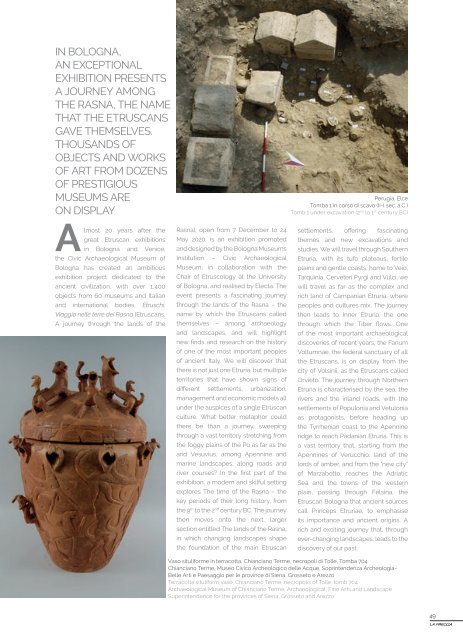You also want an ePaper? Increase the reach of your titles
YUMPU automatically turns print PDFs into web optimized ePapers that Google loves.
IN BOLOGNA,<br />
AN EXCEPTIONAL<br />
EXHIBITION PRESENTS<br />
A JOURNEY AMONG<br />
THE RASNA, THE NAME<br />
THAT THE ETRUSCANS<br />
GAVE THEMSELVES.<br />
THOUSANDS OF<br />
OBJECTS AND WORKS<br />
OF ART FROM DOZENS<br />
OF PRESTIGIOUS<br />
MUSEUMS ARE<br />
ON DISPLAY<br />
Perugia, Elce<br />
Tomba 1 in corso di scavo (II-I sec. a.C.)<br />
Tomb 1 under excavation (2 nd to 1 st century BC)<br />
Almost 20 years after the<br />
great Etruscan exhibitions<br />
in Bologna and Venice,<br />
the Civic Archaeological Museum of<br />
Bologna has created an ambitious<br />
exhibition project dedicated to the<br />
ancient civilization, with over 1,400<br />
objects from 60 museums and Italian<br />
and international bodies. Etruschi.<br />
Viaggio nelle terre dei Rasna (Etruscans.<br />
A journey through the lands of the<br />
Rasna), open from 7 December to 24<br />
May 2020, is an exhibition promoted<br />
and designed by the Bologna Museums<br />
Institution – Civic Archaeological<br />
Museum, in collaboration with the<br />
Chair of Etruscology at the University<br />
of Bologna, and realised by Electa. The<br />
event presents a fascinating journey<br />
through the lands of the Rasna – the<br />
name by which the Etruscans called<br />
themselves – among archaeology<br />
and landscapes, and will highlight<br />
new finds and research on the history<br />
of one of the most important peoples<br />
of ancient Italy. We will discover that<br />
there is not just one Etruria, but multiple<br />
territories that have shown signs of<br />
different settlements, urbanization,<br />
management and economic models all<br />
under the auspices of a single Etruscan<br />
culture. What better metaphor could<br />
there be than a journey, sweeping<br />
through a vast territory stretching from<br />
the foggy plains of the Po as far as the<br />
arid Vesuvius, among Apennine and<br />
marine landscapes, along roads and<br />
river courses? In the first part of the<br />
exhibition, a modern and skilful setting<br />
explores The time of the Rasna – the<br />
key periods of their long history, from<br />
the 9 th to the 2 nd century BC. The journey<br />
then moves onto the next, larger<br />
section entitled The lands of the Rasna,<br />
in which changing landscapes shape<br />
the foundation of the main Etruscan<br />
settlements, offering fascinating<br />
themes and new excavations and<br />
studies. We will travel through Southern<br />
Etruria, with its tufo plateaus, fertile<br />
plains and gentle coasts, home to Veio,<br />
Tarquinia, Cerveteri Pyrgi and Vulci; we<br />
will travel as far as the complex and<br />
rich land of Campanian Etruria, where<br />
peoples and cultures mix. The journey<br />
then leads to Inner Etruria, the one<br />
through which the Tiber flows. One<br />
of the most important archaeological<br />
discoveries of recent years, the Fanum<br />
Voltumnae, the federal sanctuary of all<br />
the Etruscans, is on display from the<br />
city of Volsinii, as the Etruscans called<br />
Orvieto. The journey through Northern<br />
Etruria is characterised by the sea, the<br />
rivers and the inland roads, with the<br />
settlements of Populonia and Vetulonia<br />
as protagonists, before heading up<br />
the Tyrrhenian coast to the Apennine<br />
ridge to reach Padanian Etruria. This is<br />
a vast territory that, starting from the<br />
Apennines of Verucchio, land of the<br />
lords of amber, and from the "new city"<br />
of Marzabotto, reaches the Adriatic<br />
Sea and the towns of the western<br />
plain, passing through Felsina, the<br />
Etruscan Bologna that ancient sources<br />
call Princeps Etruriae, to emphasise<br />
its importance and ancient origins. A<br />
rich and exciting journey that, through<br />
ever-changing landscapes, leads to the<br />
discovery of our past.<br />
Vaso situliforme in terracotta, Chianciano Terme, necropoli di Tolle, Tomba 704<br />
Chianciano Terme, Museo Civico Archeologico delle Acque, Soprintendenza Archeologia-<br />
Belle Arti e Paesaggio per le province di Siena, Grosseto e Arezzo<br />
Terracotta situliform vase, Chianciano Terme, necropolis of Tolle, tomb 704<br />
Archaeological Museum of Chianciano Terme, Archaeological, Fine Arts and <strong>La</strong>ndscape<br />
Superintendence for the provinces of Siena, Grosseto and Arezzo.<br />
49

















